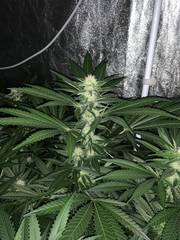-
Posts
280 -
Joined
-
Days Won
4
Content Type
Profiles
Forums
Calendar
Gallery
Articles
420 Directory
Classifieds
Everything posted by Budwizer
-
Big shortage of dank in two months dudes. Better save some for the drought ahead. Im managing to keep the lights and environment running, but it costs an arm and a leg.
-
That’s a Ca deficiency. Calmag could work, but it isn’t organic, and can mess with your pH. You’ll also be adding N, since “Calmag” is actually Calcium Magnesium Nitrate. You need a fast acting organic Ca.
-
Don’t worry wont last long enough to attract anything. Trailblazer, you need to make another plan there dude.
-
Sanlight S4W
-
This is true for HPS. New lighting tech is changing the game. Controlling ambient temperature for the sake of it is misguided. You need to achieve the correct Leaf Surface Temperature, for optimum photosynthesis and transpiration. The correct ambient temperature for HPS, cannot be the correct ambient temperature for LED. Without the massive amounts of infrared wavelengths, HPS produce, LED lights need higher ambient temperature, to compensate for the cooling effect of evaporation, from transpiration. Point is, with new lighting technologies, you need to measure the LST ( cheap infrared laser thermometer) and adjust your ambient, to achieve an LST of 25/26 C. FYI: Set emissivity to 0.98 on your laser thermometer, for green foliage.
-
Truth is, if you’re really growing organic, you shouldn’t even be “feeding “. Organics is about growing in a soil that has everything the plant needs, from the start, and relying on the soil microlife to make those things available to the plant, as the plant needs it. Your job in organics is to nurture the soil life. You can add things to help the soil life along, and increase the populations of those creatures by using teas. You add the feedstock for the plant when you first mix your soil.
-
Bat Guano is a difficult one. High in P. Check Jamiesgardenshop.co.za
-
I’m on a mission to find Greensand- Glauconite mineral. There is a large deposit off the west coast, but it’s apparently not financially viable to mine it.
-
I’ve been growing in organic soil for a number of years now. My ingredient list is pretty stable, but I love trying new things. I finally got around to reading the Revs’ True Living Organics, and Teaming with Microbes, by another author. Problem is, you struggle to find quality inputs in JHB. Consistency is nowhere. The stuff just about everyone sells as compost is far from it. All the nursery brand names, except Talborne are pretty much useless. My last bag of Fertilis EWC was mostly sand. So, what ingredients do you struggle to get your hands on? What would you like to have access to, that you cannot find now? Ever wanted FAST Ca, without the pH swing, or the Mg? How bout not paying an arm or a leg for Kelp. Ever wanted to try blood meal? Let me know what would rock your boat, If it were available.
-
There are two ways to determine the concentration of solutes in a solution: mass spectrometry, or EC. Any pen that gives you an indication of “how much stuff is in solution” is measuring EC. No pen or instrument measures PPM. PPM is an approximation, based on the conductivity of known salt concentrations of KCl or NaCl, as alemo said. In other words, pens scaled in PPM are measuring EC, and then applying a conversion factor to give an approximate PPM.
-

Diagnosis by leaf irregularities
Budwizer replied to Weed O Matic's question in General Questions & Answers
Those are classic symptoms of some sort of root damage. Poor drainage, aeration, pests. Rotting/ damaged roots cannot transport nutrients. Leaf damage never recovers. Some yellowing can certainly recover, but necrosis is permanent. Try lifting the root ball out of the pot. See if the roots are white and healthy. If not, aeration or drainage or both. Check for fungus gnats, they can cause those symptoms. Fungus gnats are themselves a symptom of overwatering. Your harvest is near, so not much you can do to improve the situation now, but browse this forum for a better soil mix next time. -
Oh yeah looking at your jiffy’s, they’re too wet. You gotta give them a little shake to drop some water after you expand them. See that dark colour the cover makes where it touches the peat? You only wanna see that on the bottom third of the jiffy. Add water with a spray bottle everyday if you don’t see that darkness on the bottom third, but don’t let the peat get saturated like in your pics.
-
You can take the propagator lid off now. The key difference between transplanting into a small pot or a big pot, is how much moisture you expose the seedling to. You can water to saturation in a small cup, and it’ll dry out in two or three days, no problem. Water too much in that Woollies pot, and it’ll stay wet for weeks, which could cause issues. So only pour a half cup of water around the seedling, for now. Get the temperature up in the propagator. I run 27.5 C. My seeds are up in two to three days. Get a 400w HID setup. MH for veg, HPS for flower. You’ll get the best results overall from that, provided you can manage temps and air exchange. Progress to LED. Your next move is airflow. Fresh in, stale out.
-
I can’t see the pictures but just from your description I can congratulate @ydt on his diagnosis. Soil and worm castings make for a terrible substrate. Worm castings become sloppy anaerobic muck without aeration. You need to add lots of perlite to that mix. If you don’t transplant into a better substrate now, you might as well chuck those plants.
-
No salvation necessary The plants were harvested, and the meds are good!
-
So, turns out my light meter sensor is not cosine corrected. My meter is reading low. Cosine correction is not linear, so one cannot just add, say 20%, but it’s what I have until I can hunt down a formula for cosine correction. My guesstimate is that the above plants were actually seeing around 900 umol.
-
In the spirit of sharing experiences, Here’s a pic of what LED light burn looks like. I have done a lot of research regarding how many umols I should be covering my canopy with. Firstly, it’s very seldom you find growers with the instruments to back up what they’re saying. A distance figure means little when everyone is using different lights. Even the manufacturers distance rating goes out the window when you’re using more, or less lights. The best info I’ve found, stated 700umol/m2/s as the golden number for LED. This one plant in my current run got a little more than that for about a week. So, I’ve raised my lights a little and getting an even 600umol/m2/s now. Based on my experience and measurements, I’d recommend 600 as the upper limit for full spectrum LED without CO2.






